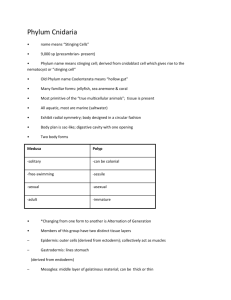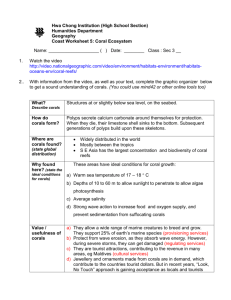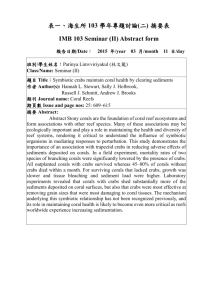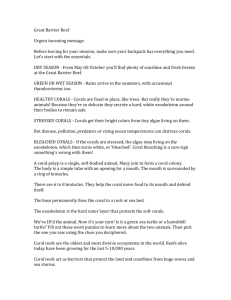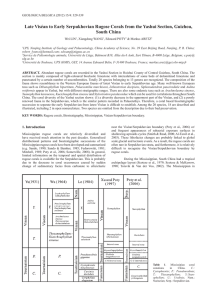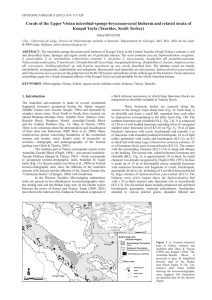Practical 3: Corals and Brachiopods
advertisement
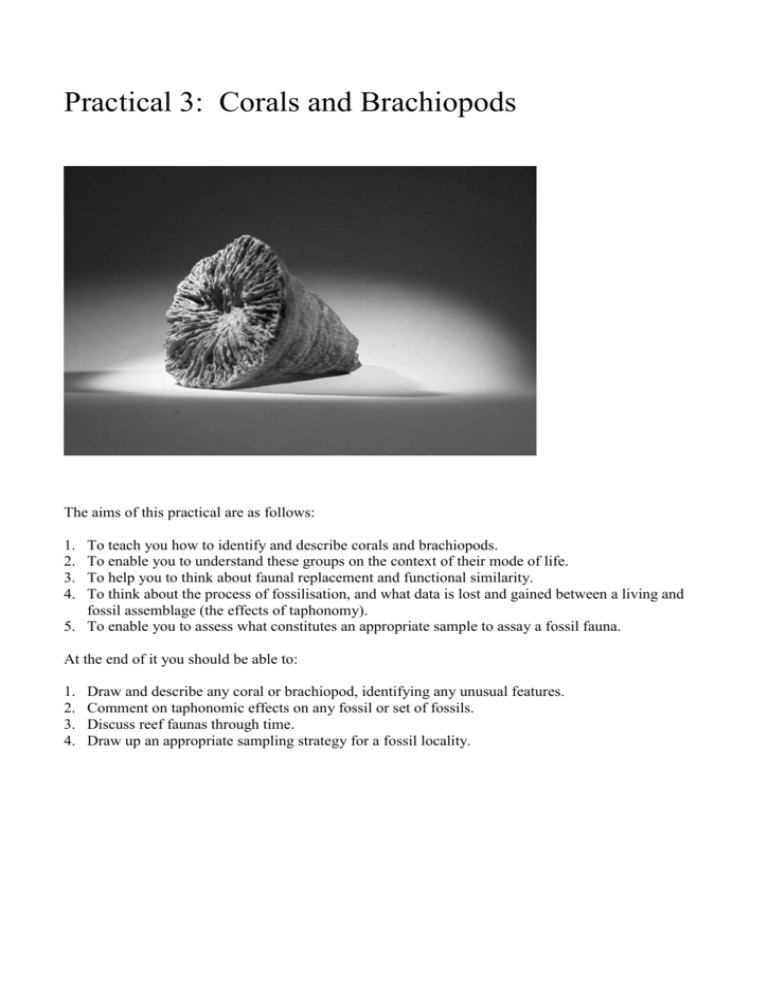
Practical 3: Corals and Brachiopods The aims of this practical are as follows: 1. 2. 3. 4. To teach you how to identify and describe corals and brachiopods. To enable you to understand these groups on the context of their mode of life. To help you to think about faunal replacement and functional similarity. To think about the process of fossilisation, and what data is lost and gained between a living and fossil assemblage (the effects of taphonomy). 5. To enable you to assess what constitutes an appropriate sample to assay a fossil fauna. At the end of it you should be able to: 1. 2. 3. 4. Draw and describe any coral or brachiopod, identifying any unusual features. Comment on taphonomic effects on any fossil or set of fossils. Discuss reef faunas through time. Draw up an appropriate sampling strategy for a fossil locality. Part 1: Corals Hard corals, with a skeleton of calcium carbonate, have been important reef builders for much of the Phanerozoic. As such they have taken part in forming an ecosystem, with a raised an complicated topography above the sea bed. There are three major types of corals, each of which evolved separately from a soft-bodied ancestor. The three have a similar morphology, because their skeleton had to perform a similar function. However, their detailed morphology is distinct. A brief key below will enable you to identify any coral to this level. Tabulate corals range from the Ordovician to Permian, but are mainly Lower Palaeozoic in age. Rugose corals have the same range, but were most common in the Silurian and Carboniferous. Scleractinian corals range from the Jurassic to the Recent. You are provided with three coral specimens. Using the key, you should identify them as rugose, tabulate or scleractinian corals. Make a representative drawing, or set of drawings for each, making especially sure that you illustrate the key features that enable you to classify them in the key. Give a brief description of each coral. In your drawings and descriptions remember scales, or measurements of appropriate features, and remember to label the view from which the fossil is drawn. Coral specimen Solitary coral Is the centre of the corallite empty or full of septae? Empty: Tabulate coral Mirror plane: Rugose coral Colonial coral Is the centre of the corallite empty or full of septae? Full: Are the septae symmetrical or is there a mirror plane of symmetry? Symmetrical: Scleractinian coral. Empty: Tabulate coral Full: Are the septae radially symmetrical or is there a mirror plane of symmetry ? Mirror plane: Rugose coral Figure 1. Identification key for the three main groups of hard corals. Hint: the central structure may show this most clearly Symmetrical: Scleractinian coral. Coral 1: Coral 2: Coral 3: A. B. Corallites – individual skeletal elements occupied by one polyp. These tend to be small in tabulate corals, and to lack complicated internal structures. Coenenchyme – shared calcareous tissue that conjoins corallites in highly interconnected colonies. Septa – small or absent in tabulate corals. This example shows small septa that grew a short distance from the corallite wall. Individual corallites are linked into a corallum shaped like a chain (cateniform). The shape of the corallite and the corallum are highly variable in corals Tabulae – horizontal plates which cut the corallite into a series of chambers. These represent the base of the section of the calice occupied by the polyp at different times during its development. Corallum is built of calcite and is a solid structure. Figure 2. Main features of the hard part morphology of tabulate corals. A. Halysites, B. Heliolites. Central structure – frequently developed from a range of other skeletal elements. Septa – everted over the rim of the calice in most scleractinian corals. Inserted regularly around the corallite. Corallum – the shape of the colony is highly dependent on environmental factors. Lightly constructed from porous aragonite. Figure 3. Major elements of the hard part morphology of scleractinian corals. This example is Confusastraea. Calice – convex surface at the top of the corallite, occupied by the polyp. Septa project into the calice, providing a secure attachment surface for the animal. Dissepiments – small, upwardly convex plates which are often developed in a marginal zone at the edge of the corallite. A. Septa – radially arranged, vertical plates, added within the corallite in a characteristic pattern (see opposite). Central column (columella) – common in rugose corals and developed from the modification of a range of other structures including tabulae and septa. Corallite – often horn shaped in solitary corals. Usually constructed from calcite. C. B. Tabulae – horizontal plates dissecting the corallite. Mature septa with fossulae Septa are added on the ‘cardinal’ sides of the alar and counter lateral septa. Counter-lateral septa added. Alar septa added Coral grows Cardinal and countercardinal septa develop. Corallite shape – controlled by the overall shape of the colony in many rugose corals. In this example, close contact between adjacent corallites causes them to grow in a polyhedral shape. Corallum – the whole coral colony. Most commonly massive and dome shaped in rugose corals. Its shape was modified by the environment. Figure 4. Major features of the hard part morphology of rugose corals. A, Generalised solitary coral; B, . The sequential development of septa within a rugose coral. C, Generalised colonial coral. Part 2: Reef taphonomy Reefs, sometimes built by corals, sometimes by other groups of organisms, have been a feature of the marine realm since the Cambrian. In some ways they appear to be ideal fossils. They are solid structures, built of durable material, large in scale, and carrying useful environmental information. As such they are ideal for thinking about taphonomy. Taphonomy is the study of information loss and gain between a living and a fossil assemblage. It covers information loss or bias due to sorting and decay, and the loss and gain inherent in the chemical processes of fossilisation. You are provided with two photographs, one of a modern reef, the other of a fossil reef, the Wenlock Limestone for the Silurian of Wales. Use these to help you to think about taphonomic processes that affect reefs. Try to answer the questions set out below. You should do this in a group of between two and four. More useful information is available on the side bench. 1. Can you identify bias that would be likely to occur in faunas between a living and a fossil reef? a. Bias by trophic level (eg producers, consumers, carnivores)? Most primary producers in the marine realm lack skeletons – they are either algae or phytoplankton. They have a low chance or preservation. Some corals have symbiotic primary producers, and some in the past might also have had this, but the only way to infer this will be indirectly, by assaying the geographical distribution of fossils, or perhaps by assessing how easy it was for them to produce calcium carbonate Carnivores tend to be rare and active. They also tend to be vertebrates. This means their chances of preservation are low, and if they do preserve they are likely to be in bits and may be difficult to identify. b. Bias by type of skeleton? Hard parts are more likely to fossilise than organisms that don’t have them. Of these, agglutinated skeletons tend to fall apart. Some calcareous skeletons dissolve, either due to environment or because they are aragonitic. Articulated skeletons fall to bits, especially echinoids and vertebrates. Thick, one piece skeletons fossilise much better than thin, skeletons with several pieces. c. Bias by mode of life, for example, sessile, swimming, burrowing? d. Bias by position on the reef (eg forereef, backreef, reef front)? 2. What elements of information are lost as a result of fossilisation, regardless of whether the organisms is preserved in some form? For example, colour is not usually preserved in fossils. 3. Can you think of any information that might be gained during fossilisation? Part 3: Brachiopods You are provided with two brachiopods. Produce detailed anatomical drawings of these. You should concentrate particularly on the elements of symmetry shown by the shell. This is because brachiopods are superficially like bivalves (which you will see in practical 4) and can be confused with them. Brachiopods have a mirror plane of symmetry that bisects the shell. Bivalves have a mirror plane of symmetry between the shell (usually). Brachiopod 1: Brachiopod 2: A Pedicle foramen – opening for pedicle Delthyrium - closed by deltidal plates Commissure – line where valves meet Ventral valve Umbo – rounded area which marks point of valve growth Rib Growth line B Interarea - ventral valve Dorsal valve Notothyrium Delthyrium Interarea - dorsal valve Figure 5. Brachiopod external morphology A. Astrophic B. Strophic Mode of life Infaunal Burrowing Semi-infaunal (partial burrowing) Epifaunal Attached by pedicle Encrusting Cementing Unattached Shell form Substrate Example Smooth Spines on ventral valve Soft-bottom Soft sediment overlying hard-bottom Lingula Konchiproductus Pedicle opening Closed pedicle opening, irregular ventral valve Closed pedicle opening, ventral spines, umbo scar Closed pedicle, saucershaped Hard-bottom Hard-bottom Megellania Crania Hard-bottom Chonosteges Hard or soft-bottom Rafinesquina Table 1. Table relating mode of life to morphological characters in brachiopods. Part 4: Sampling a brachiopod assemblage. One of the main problems encountered by palaeontologists is knowing how many specimens need to be collected to form a representative sample of a given locality. If the sample is too small, then critical species may be missed. Too large, and the work involved in processing the data is partly redundant. Cumulative number of species One of the commonest ways to resolve this is with a rarefaction curve. This is a plot of the number of specimens collected against the cumulative number of species identified. Initially, new species are encountered frequently. Slowly, the number of new species found declines and the curve levels off. When it reaches a more or less flat line, then the locality is considered to be adequately sampled. Adequate sample number Specimens collected (batches of ten) (log scale) Figure 6: Sketch of a rarefaction curve. You are provided with a set of 10 brachiopods collected from Shadwell Quarry in Shropshire. The assemblage is from a Silurian muddy sea floor. Identify your brachiopods using the key below, and add these data to the rarefaction curve on the computer screen. Please follow the instructions next to the computer carefully. At the end of the practical note the number of specimens that adequately samples this assemblage.



